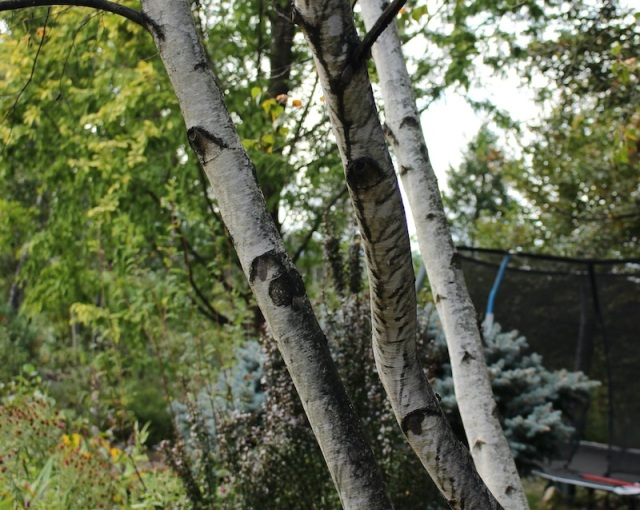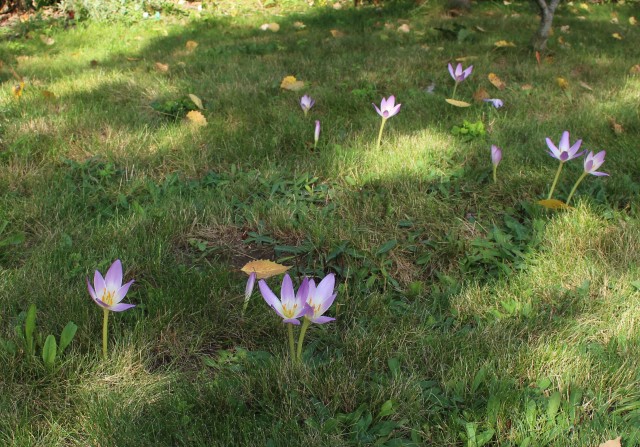So yeah, another day lost to endless rain… I actually cleaned the kitchen and cooked some food for the fam instead of escaping to the garden. Nothing healthy was cooked, I’m a maestro with the deep fryer, but for a gloomy and gray, chilly day it seemed appropriate. Now it’s 9pm and after several apathetic attempts at a blog post throughout the day, I suppose a firmer tone should be set and anything should be posted. Photos were taken yesterday for just this purpose, so maybe something good can come of a day with no garden time.
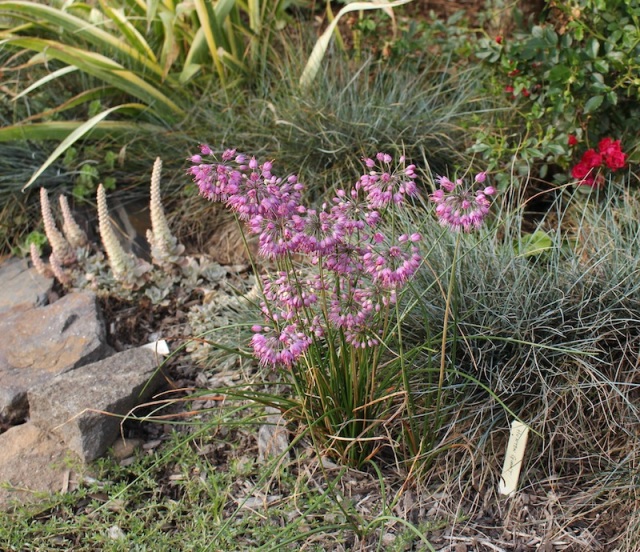
Allium thunbergii ‘Ozawa’ has finally opened. Although I’m the only one to notice so far, I’ve been checking him each day waiting for just this moment and that’s exciting.
The biggest news is that after years of no Allium thunbergii, I’m suddenly basking in the joy of four separate plantings. One of them really doesn’t count. It’s the miserable patch of seedlings which I’ve been nursing along for at least seven years, and has only bloomed once in all that time. I don’t want to talk about it. I do want to gush on about the two I picked up at a NARGS plant sale, and then the one which showed up a few weeks later when a friend was nice enough to send me a division as well. From a thunbergii desert to a garden flooded with October blooming alliums was more than I could hope for, and now in their second year here I’m quite pleased. My friend sent the cultivar ‘Ozawa’ and the other two are maybe a straight species form, and the white ‘Album’, and all three are putting on a great show.
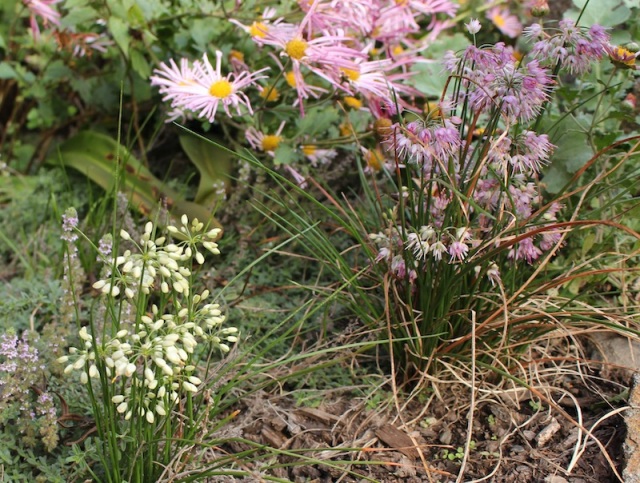
The small white Allium thunbergii album with another A. thunbergii which was just labeled ‘pink’. These two are showing off just inches away from another patch which rarely flowers… It’s hard admitting that one of your babies is a little ‘lacking’.
Now before I start mulling over the idea that an early fall-blooming snowdrop would complement these alliums wonderfully, lets check off the last of the colchicums. In this garden the long-blooming, double white C. autumnale ‘Alboplenum’ finishes off the season, and this late favorite now comes up in a couple spots around the yard. It should be a couple more, but the colchicum transplanting steam has cooled off, and it looks like these are going to have to wait until next summer to get a little more space and maybe a little more sun elsewhere.
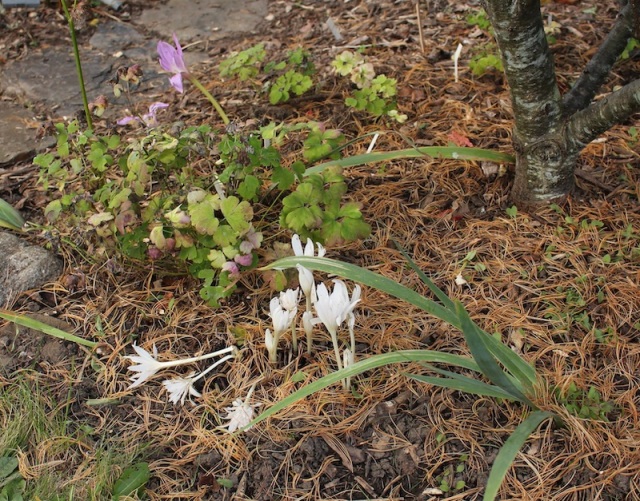
Colchicum autumnale alboplenum looking slightly sparse and tired, but still giving a decent show under a dwarf white pine. I always like how the falling needles blanket the ground for the colchicum, but the dry shade doesn’t always please the colchicum.
The steam on a few projects has cooled down, and maybe that’s where the rain is coming from, but the focus is now turned to embracing the new wheelbarrow and moving dirt again. Pickaxe a few square feet, shovel them out, wheel them back, repeat… and then go sit down for a couple minutes. No sense in wearing yourself out, and absolutely no reason that a gardener should be working so hard as to sweat in mid October.
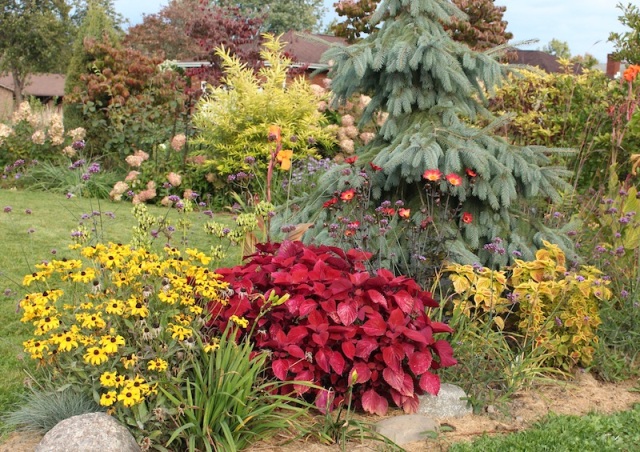
One of the rest seats faces the end of the front border. Things are beginning to wind down, but as long as frost holds off there’s still plenty of color.
As I’ve probably mentioned way too many times, this garden isn’t built on the deep, fertile soils of a lush river valley, it’s just a few inches of topsoil skimming the top of construction fill, which sits just above rocks and bedrock… and then if you keep going coal mines will be the only other excitement down there. Roots do not go deep, and I’m always trying to improve on that, even if it’s in ways which often do more than they should to avoid anything which seems like real work, or even worse, sound like they could be costly.
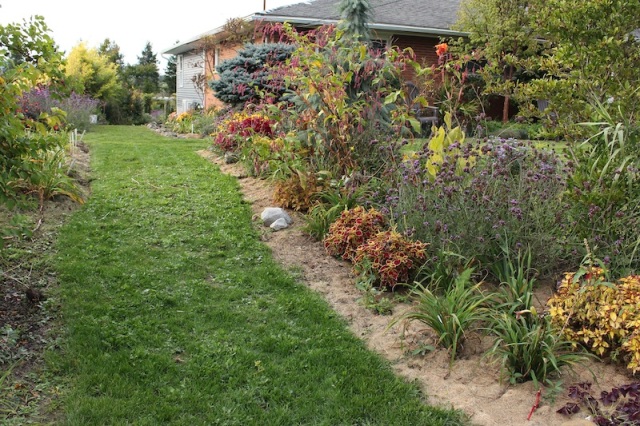
At least the newly seeded lawn has been enjoying all the rain. This area was completely dug up and bulldozed and I’m counting on mulches like lawn clippings to bring life back and re-create some topsoil.
Sifting out rocks, double digging beds, working in amendments and soil conditioners, and buying in ‘topsoil’ are all great ideas, and I love seeing other gardeners do it and then watch as their spades slice through a delicious chocolate cake soil to plant things, but there’s about a zero chance that will ever happen here. Here my main method of attack is (1)dump organic matter on top and (2)wait for the worms and other creatures to work it into the soil, and (3)grow lots of things. Growing things have roots, and the roots work through the soil, and when they die they leave a path and organic matter… so let me alter that and say (3)grow lots of things and then kill them but leave the roots there. You can probably guess I’m not one to worry about removing stumps, and pulling things up and getting all the roots? Also not a priority.
Of course some roots have to come out, but wherever I can I try to smother weeds with a layer of mulch first. Lately lawn clippings have been my mulch of choice, and from snowdrops to daylilies to boxwoods, they’re all getting a nice inch or two.

The lawn alone doesn’t give enough clippings, so this is when the meadow gets a scalping as well. All the rain has it pretty lush so hopefully it’s more clippings than weed seeds, but even a few weeds are worth it.
A cleaned out bed is easier to mulch, so chopping back has started and where better to throw the spent stalks and fading foliage than on the lawn? It all gets mowed up and thrown back onto a bed elsewhere and all that organic matter stays around the plants which produced it. Things doesn’t look 100% fancy, but is so much easier than hauling it to the compost. It’s only the hellebores which don’t get their own shredded foliage returned to the same bed, and phlox stems also go elsewhere. These are the only plants which give me any kind of build-up of disease concerns. Everything stays in the garden, it just moves to a different part with other plant species.
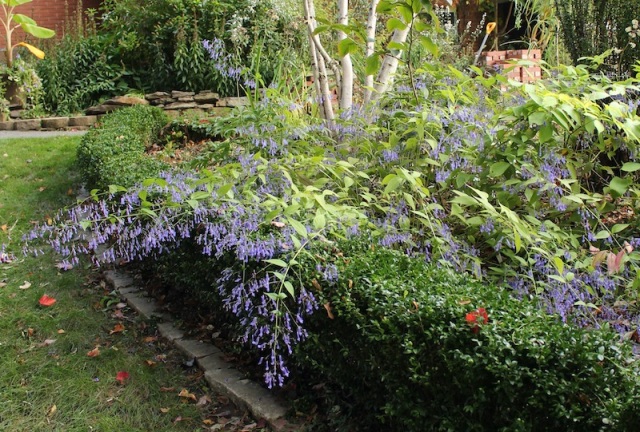
Isodon effusus, formerly rabdosia, formerly plectranthus, is flopping all over the snowdrop bed and in full bloom. It’s impossible to photograph, and the name is impossible to remember, but it does bring in some excellent color, even better when the red maples begin dropping their leaves alongside the blue.
Golly does the rain have me chatty. I’m moving dirt, building soil, and the only other thing I still want to mention is power washing. The spotted lanternfly is into its third year here and is about as bad as last. They’re mostly annoying with their clumsy hopping and bumbling flight, but their honeydew pee is beyond annoying and enters irritating. The sweet pee is gross, but the black mold it grows is disgusting. The black mold is the reason you haven’t had to endure endless succulent wall photos, since most of my succulents are blackened by the drizzle they get under the aspens. Pretty much anything around the bases of trees is sticky and black, and of course the white birches don’t show well either when they’re dripping with pee and mold.
According to most Lanternfly information I should be stomping and spraying and controlling the beasts as best I can, but I’m not. When the mold started getting bad I briefly considered pulling out the shop vac and making a brush attachment to sweep the trees clean, but you can guess where that ended up. Cracking open a beverage, pulling up a lawn chair, and vacuuming up a wasp nest is fun, but running the vacuum up and down trees for the lanternflies seem like work, so no thanks. I’ll take this first hit in stride and hope it balances itself out similar to the Asian ladybugs, Japanese beetles, stinkbugs… hmmmm there’s quite a menu of invasive pests which have come this way over the years…
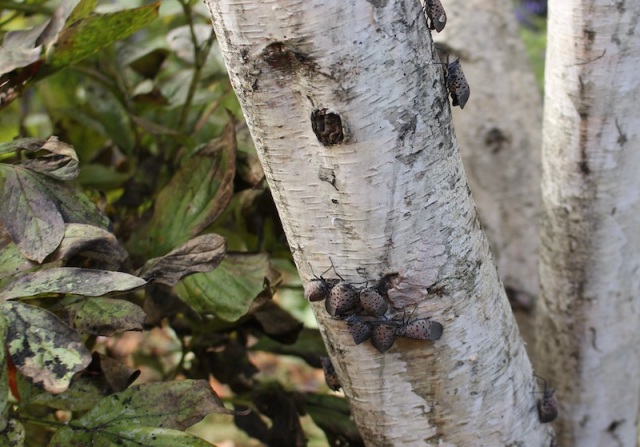
Spotted lanternflies beginning to lay eggs at the base of the tree, alongside the blackened foliage of a peony.
Let’s leave off on a good note… as the patter of rain on the roof has picked up yet again…
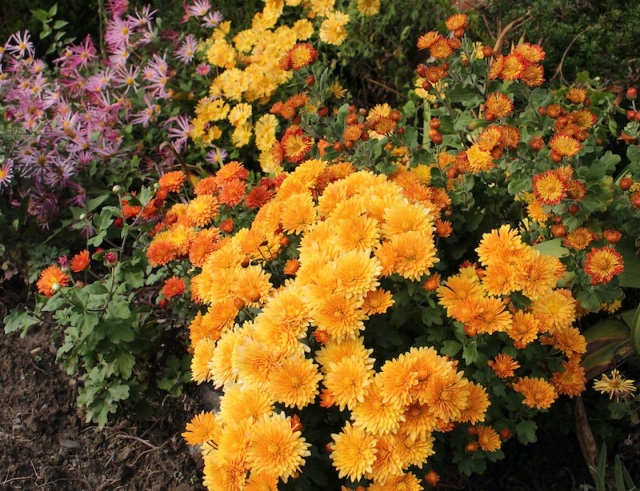
Each fall I keep wanting to transplant a few of these hardy garden chrysanthemum seedlings to more spots around the garden and each spring my attention is elsewhere. Today this double orange is my favorite. I should collect seeds when they’re done and play that game again 😉
So that’s a post, for better or worse. I hope if anything it entertained, and I also hope that your Sunday is sunny and enjoyable!
